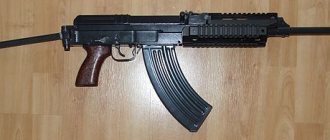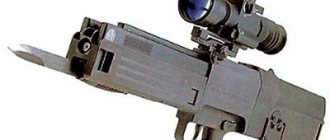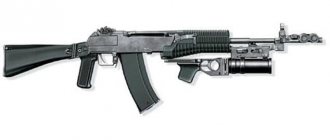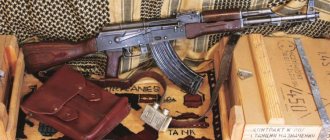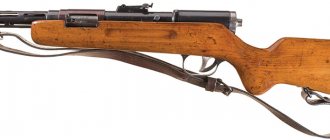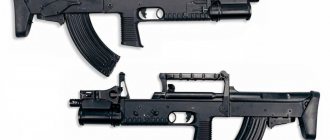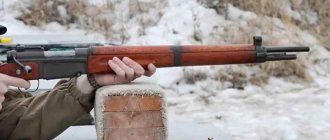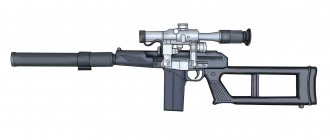They say that this particular weapon was the prototype of the famous Kalashnikov assault rifle and the equally famous Belgian FN FAL assault rifle.
They say that this particular weapon already had a standard place for an under-barrel grenade launcher, an optical sight and other “body kit”.
They say that it was from this weapon that the terms “assault rifle” and “intermediate cartridge” appeared in the modern military lexicon.
And all this is the pure truth!
The history of the creation of this weapon began even before the Second World War with... the development in the 30s of the 20th century of the “intermediate cartridge” 7.92 × 33 mm (7.92 mm Kurz). This cartridge was intermediate in power between a pistol (9×19 mm “parabellum”) and a rifle (7.92×57 mm for the Mauser-98K carbine).
This cartridge was developed not by order of the military department, but on its own initiative by the German arms company Polte. In 1942, the German arms department HWaA transferred the order for the development of weapons for this cartridge to two German companies - CG Haenel and Karl Walther.
As a result, an automatic weapon was created, called MaschinenKarabiner (automatic carbine). The sample created by the Walter company was designated MKb.42(W), the sample from the Haenel company was designated Mkb.42(H).
Based on the test results, it was decided to develop the design of the Henel company, the development of which was led by the legendary German gunsmith Hugo Schmeisser; significant changes were made to it, for example, the design of the trigger mechanism was taken from the Walter company sample.
Further development of the automatic carbine continued under the letter MP 43. The name change to MaschinenPistole (literally translated submachine gun) is due to the fact that Adolf Hitler categorically objected to the mass production of automatic weapons, citing the fact that there were then millions of rifle cartridges in warehouses. and will not be used. Even the demonstration of the capabilities of an automatic carbine did not change the Fuhrer’s negative attitude towards new types of automatic weapons. Further development of these weapons was carried out in secret from the Fuhrer, under the personal supervision of the Reich Minister of Armaments Albert Speer.
Still, new weapons were vitally needed. By the middle of the war, the firepower of the German infantry gradually turned out to be significantly lower than the firepower of the Soviet infantry, armed mainly with the PPSh submachine gun. This, in turn, required either the production of a huge number of light machine guns, which were bulky and inconvenient, or the start of mass production of automatic carbines, the effective firing range of which was up to 500 m (for PPSh up to 150 m).
The attitude of the Fuhrer and the entire supreme leadership of the Third Reich to the new weapon changed dramatically, and at the beginning of 1944, mass production of a new type of weapon began under the name MP 44. The elite units of the German army were primarily equipped with these weapons. At the same time, ammunition is also being improved: the 1943 model cartridge “Pistolen-Part. 43 m. E" was already very similar to a modern machine gun cartridge with a steel core in the bullet. In October 1944, the sample received the final (personally chosen by the Fuhrer) designation StG.44 (Sturmgewehr 44, “assault rifle model 1944”). The name “assault rifle” has become so “stuck” to this type of small arms that all small arms with similar performance today are called assault rifles.
Stg.44 (assault rifle model 1944)
The Stg.44 automatic carbine was an individual small weapon, built on the basis of an automatic weapon with a gas engine with a long stroke of a gas piston located above the barrel. The barrel was locked by tilting the bolt downwards, behind the liner in the receiver. The receiver consists of a steel sheet; a stamped trigger block together with a pistol grip is attached to the receiver and folds forward and down when disassembled incompletely. The stock is wooden, attached to the receiver and removed during disassembly. There is a return spring inside the butt. Although I have seen photographs with a folding stock, I have not found a description of such a model.
The trigger mechanism allows for single and automatic fire. The sight is sectorial, the safety and fire mode selector are independent, the bolt handle is located on the left and moves with the bolt frame when firing. The muzzle of the barrel has a thread for attaching a rifle grenade launcher, and the Stg.44 could be equipped with a special Krummlauf Vorsatz J curved-barrel device, designed for firing from tanks, trenches or other shelters.
General information[edit]
At the end of 1942, the command of the German armed forces came to the conclusion that it was necessary to develop new small arms that combined the rate of fire of a submachine gun and the power of a rifle. As it turned out, the range of the rifles was excessive for infantry combat, the distance of which, instead of the expected 700-800, was no more than 300 meters. A new cartridge was developed especially for this weapon, which had a rifle caliber of 7.92 mm, but the cartridge case was half as long as that of the Mauser cartridge. Such cartridges are now called intermediate. The mass of its bullet was not much lighter than that of a rifle (8.1 grams) and retained high destructive power at a distance of over 1000 meters.
However, the new weapon almost remained in the state of several prototypes, since, according to Adolf Hitler, its cartridge was not powerful enough, and the release of a new type of ammunition during the war was unacceptable for the Reich military industry and the economy as a whole. Therefore, the developers resorted to a trick: the experimental batch was designated “Maschinenpistole-43” and was sent to the Eastern Front in 1943. Only after receiving warm approval from the troops did the Fuhrer finally realize the importance of the new product and even came up with a new name for it (including for propaganda purposes) - SturmGewehr, that is, “assault rifle.” However, the Mauser 98K rifle and the MP 40 submachine gun were never supplanted by the Sturmgever. The only exception was the SS troops, where by December 1944 2/3 of the soldiers had new weapons.
After World War II, the StG-44 was in service with the Hungarian, Yugoslav and East German armies until the end of the 50s, when it was replaced by Kalashnikov assault rifles.
About additional accessories
Military equipment, not provided with reliable manpower cover, became very vulnerable to enemy infantry. She disabled military equipment using magnetic mines and hand grenades. The use of tanks and self-propelled guns during combat creates a significant “dead zone” - a space that is completely inaccessible from the enemy’s standard small arms and cannon weapons. For Hugo Schmeisser's shooting model, a special device was designed that allows the weapon to be used from cover.
This device was a special curved-barrel attachment. Initially it was planned to use a 7.92x57 mm cartridge. However, it turned out to be too powerful for the curved trunk. As a result, this ammunition was replaced with a 7.92x33 mm cartridge. The curvature of the trunk is made at an angle of 90 degrees. The nozzle has a service life of up to 2 thousand shots. Later, similar devices were made with a curvature of 30 degrees.
The Kalashnikov assault rifle does not have such attachments. The AK-47 is equipped with a bayonet, which makes it possible to use it effectively in hand-to-hand combat. The product is mounted on the barrel with a special latch. Initially, the length of the double-edged blade, equipped with a fuller, was 20 cm. Later, the size was reduced to 15 cm. The blade began to be used for economic purposes.
New in blogs
In the spring of 1943, the officers of the rifle department of the GAU of the Red Army could well be satisfied with the results of their work. It seemed that the worst was over - the huge losses of weapons in the first months, the evacuation of factories, the decline in product quality - all this was gradually being corrected. Already in the fall of 1942, it was possible to “cure” the problems of Degtyarev’s anti-tank rifle. Carob magazines were developed and adopted for the Shpagin submachine gun, the bottleneck of which was a complex disk. In addition, even more technologically advanced Sudaev submachine guns began to enter service with the army. In the niche of the heavy machine guns, Goryunov’s new heavy machine gun was preparing to come to the aid of the old “Maxim”. In general, there were reasons for optimism...
...and then an alarm bell rang in the form of a report from the North-Western Front.
"Secret
Headquarters of the Artillery Commander
Northwestern Front.
To the Head of the State Autonomous Institution KA
I am sending with a special technician, Lieutenant N.N. Troitsky. a German automatic carbine and 4 cartridges for it, captured in June at the 22nd Army site in the area of the city of Kholm.”
| Mkb. 42 (H) The Soviet troops received the MKb42(H) (German: MaschinenKarabiner-42 (Haenel)) with serial number 1334 as a trophy. Apparently, this was one of the Haenel prototypes sent for testing to the 93rd Infantry Division, which was located on the Eastern Front just in the area of the city of Kholm. The “carbine” arrived at the GAU shooting range with only two cartridges, one of which was used to determine the initial speed of the bullet (694 meters per second), and the second to study the operation cycle of the automation. In this case, the rate of fire had to be determined as calculated - according to the site specialists, it should have been about 470 rounds per minute. |
As a result, the report on the first acquaintance of Soviet gunsmiths with the prototype of the future Sturmgewehr contained the following conclusions:
"1. The MKb42(H) carbine is interesting as a new type of weapon, quite light (4,500 kg - a weight corresponding to the weight of a self-loading rifle) and, at the same time, relatively powerful, apparently capable of creating quite intense and effective fire at distances up to 600 meters, which far exceeds the distances available for a submachine gun.
The small dimensions and weight of the cartridge allow you to have a reserve of cartridges with a carbine, approximately 1.5-1.8 times more than with a light machine gun. In terms of practical rate of fire, the MKb42(H) carbine should be closer to a submachine gun. The saturation of troops with a type of weapon can be much greater than the saturation with light machine guns.
Therefore, it is necessary to conduct full field tests of the MKb42(H) carbine and its cartridges.
2. The main feature of the MKb42(H) carbine is its cartridge, which, according to its characteristics, occupies a middle place between a rifle and a pistol. Noteworthy is the varnishing of the iron sleeve instead of plating and the iron capsule cup.
The production of such a cartridge was approved by the Germans quite successfully, because The basis is a standard screw chuck, strengthened and re-compressed.
3. From a design point of view, the MKb42(H) carbine is most similar to a light machine gun. It is interesting, like the original stamped design of the weapon. Particularly noteworthy is the high quality of shaped stamping, the use of spot welding and the quality of rolling the receiver into a stamped box.
It is also characteristic that the pins and axles of the trigger mechanism and the trigger box are flared at the ends and cannot be disassembled.
The butt plate fastening is extremely weak, suggesting that the system operates on incomplete recoils. Unfortunately, the lack of ammunition did not allow the system to operate normally.
The disadvantage of the design is the difficulty of accessing the inside of the receiver when eliminating various types of delays.
The release on the velocimeter indicates release under significant pressure. At a low rate of fire, this should also be considered a disadvantage (at a high rate, this phenomenon is inevitable).
A comprehensive and exhaustive assessment of the design and combat properties is possible only after full field tests.”
It’s worth jumping ahead a little here. As can be seen from the above quote, the Soviet military was fully aware that the stamped design is more technologically advanced and cheaper than the model, which requires significant milling work - which leads to high consumption of metal, cutting tools made of expensive special steels, complication and slowdown of the technical process, and so on. Even before the start of the Great Patriotic War, the then head of the GAU G.I. Kulik, regarding one of the models proposed for service, said: “I don’t need a weapon that has milling work!” Also, at competitions for new weapons held during the war, the need for the widest possible use of stamping was regularly mentioned. A successful example of meeting these requirements was, in particular, the submachine gun designed by Sudaev.
In a similar way, the first Soviet machine guns chambered for an intermediate cartridge were designed for the widespread use of stamping. However, the start of production of the M.T. Kalashnikov model that won the competition clearly showed that it was quite difficult for Soviet industry in 1949 to reach the level of Germany in 1942. Even despite the “import” from capitulated Germany of part of the machine park and a number of specialists (including the chief designer of the Haenel company and the creator of the MKb42 (H) Hugo Schmeisser), it was not possible to launch production of the “stamped” machine gun; the percentage of defects turned out to be unacceptably high. As a result, the USSR had to compromise, starting in 1951 to produce AKs with a milled receiver. It was finally possible to switch to stamping only with the adoption of the AKM in 1959.
However, this was much later. Then, in 1943, having carefully studied the captured sample, the USSR hastily began work on creating its own versions of both the cartridge and weapons for it. The assignments were issued immediately for a set of weapons: a self-loading carbine, a “heavy machine gun” and a belt-fed light machine gun.
In fact, the designers had to design weapons for a cartridge that did not yet exist. Problems with its creation and deployment of at least initial mass production also delayed the testing of new samples. According to GAU KA calculations, 300 thousand new cartridges were required only for debugging and factory testing of machine guns. in reality, 10 thousand were manufactured by the end of 1943, and another 28 thousand in January 1944. But these cartridges did not meet the ballistics requirements and had a number of manufacturing flaws (incomplete charge, tight extraction, incorrect groove, and so on).
It is interesting that one of the reasons for the appearance of the future Sturmgewehr was cited as possible dissatisfaction of the German command with the MG-34 machine gun. According to GAU officers, it turned out to be too heavy and complex for a light machine gun, and for an easel machine gun it lacked, for example, the ability to quickly and easily change the barrel. It is interesting that a similar opinion was expressed in 1944 by front-line soldiers who met the German novelty in battles - the new German weapon is rather an ersatz of a light machine gun, can be taken in 2-3 squads and will not replace submachine guns in any way.
Meanwhile, at the front, not only the MKb42, but also the MP 43/1, and then the Sturmgewehr itself, the StG 44, began to come across as trophies. However, by this time the GAU’s fears had already begun to gradually dissipate - although the number of “autocarbines” at the front was increasing , the Germans no longer had time to rearm the entire infantry with them
Andrey Ulanov.
Gallery[edit]
- A soldier with StG-44 on the march.
- Pouches for stores.
- The 7.92x33 cartridge compared to the M1 carbine cartridge and the Japanese Arisaka cartridge.
- Disassembled.
- A Soviet soldier with a captured Sturmgewehr escorts German prisoners of war.
- Yugoslav soldier with StG-44.
- Night sight of the active type "Vampire".
- An American sergeant tests a Sturmgewehr with an attachment for shooting around corners.
- With optical sight ZF-4.
- Diagram showing the dimensions of the StG-44 and .
- StG-44 and AK disassembled.
About ammunition
The detachable sector double-row magazine Stg 44 is designed for 30 rounds of ammunition. Since the magazines were equipped with weak springs, German soldiers had to load their rifles with 25 rounds. Only in this way was it possible to ensure a normal supply of ammunition. Since 1945, new magazines have been developed for this model, designed to hold 25 rounds of ammunition. They were produced in small batches. In the same year, a new magazine was created, equipped with a special stopper that limited the supply to 25 rounds.
The AK-47 is supplied with ammunition from a box-shaped, sectorial, double-row magazine, the capacity of which is 30 rounds. The magazine itself is presented in the form of a body, which contains a locking bar, a cover, a spring and a feeder. Initially, a magazine with a stamped steel body was intended for the Kalashnikov assault rifle. Over time, plastic products were created from polycarbonate and glass-filled polyamide. Kalashnikov assault rifle magazines are characterized by such qualities as reliability when supplying ammunition and high “survivability”, even during rough use. The design used in the AK has been copied by a number of foreign weapons manufacturers.
